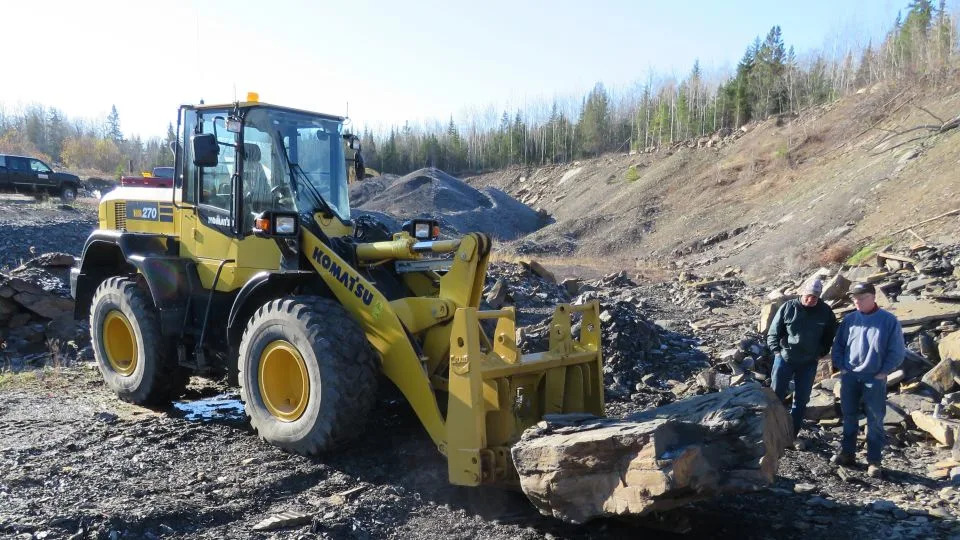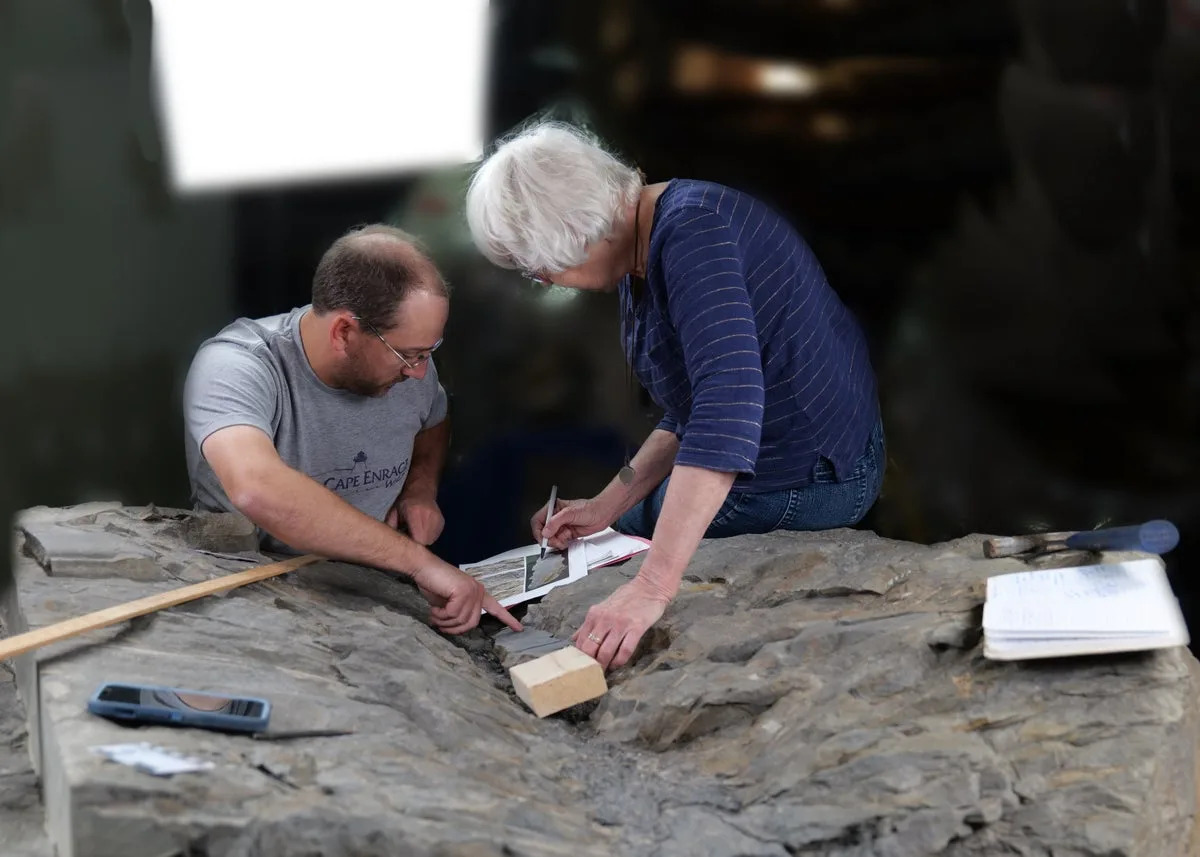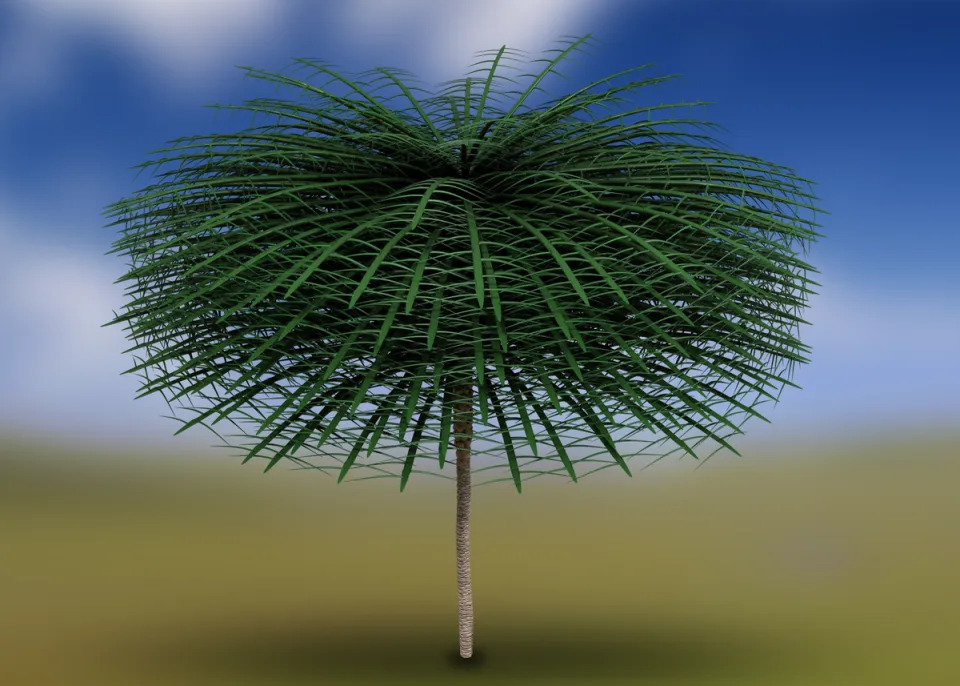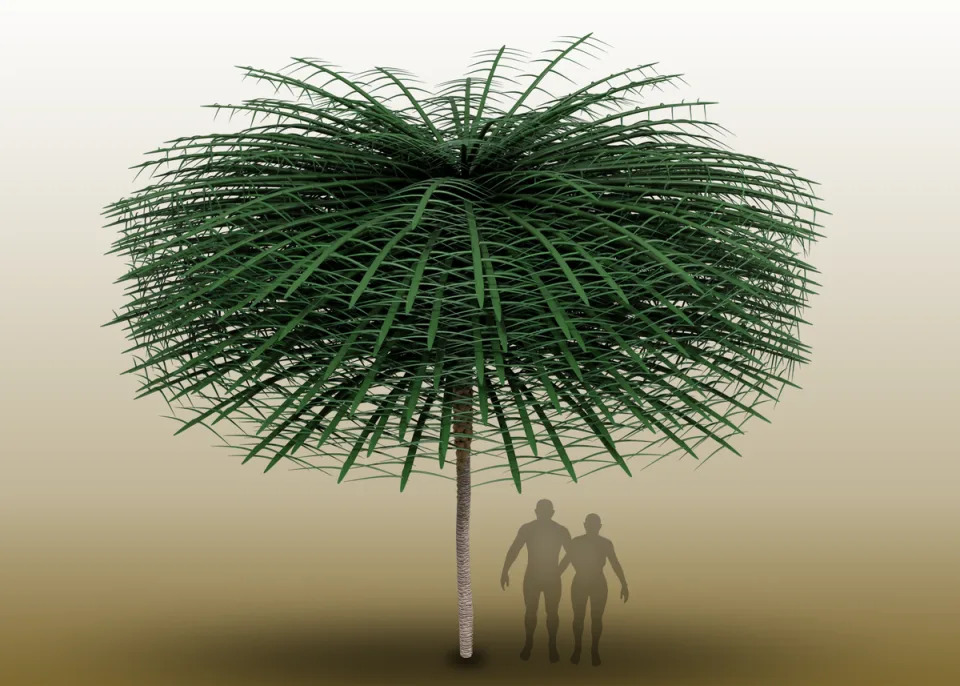Ayurella Horn-Muller, CNN
Fri, February 2, 2024
Trees are believed to have originated hundreds of millions of years ago. Ever since, evidence of these ancient plant sentinels has been in short supply.
Now, a new discovery of uniquely 3D tree fossils has opened a window into what the world was like when the planet’s early forests were beginning to evolve, expanding our understanding of the architecture of trees throughout Earth’s history.
Five tree fossils buried alive by an earthquake 350 million years ago were found in a quarry in the Canadian province of New Brunswick, according to a study published Friday in the journal Current Biology. The authors said these new and unusual fossil trees not only bear a surprising shape reminiscent of a Dr. Seuss illustration, they reveal clues about a period of life on Earth of which we know little.
“They are time capsules,” said Robert Gastaldo, a paleontologist and sedimentologist who led the study, “literally little windows into deep-time landscapes and ecosystems.”
Coauthors Olivia King and Matthew Stimson unearthed the first of the ancient trees in 2017 while doing fieldwork in a rock quarry in New Brunswick. One of the specimens they discovered is among a handful of cases in the entire plant fossil record — spanning more than 400 million years — in which a tree’s branches and crown leaves are still attached to its trunk.
Few tree fossils that date back to Earth’s earliest forests have ever been found, according to Gastaldo. Their discovery helps fill in some missing pieces of an incomplete fossil record.
“There are only five or six trees that we can document, at least in the Paleozoic, that were preserved with its crown intact,” said Gastaldo, a professor of geology at Colby College in Waterville, Maine.
Most ancient tree specimens are relatively small, he noted, and often discovered in the form of a fossilized trunk with a stump or root system attached. For his colleagues to find a preserved tree that could have been 15 feet tall in its maturity with an 18-foot diameter crown left the paleontologist “gobsmacked.”

This model rendering of the newly discovered Sanfordiacaulis tree includes simplified branching structure for easier visualization. - Courtesy Tim Stonesifer
Ancient earthquake burial
The researchers excavated the first fossil tree about seven years ago, but it took another few years before four more specimens of the same plant were found in close proximity to one another. Dubbed “Sanfordiacaulis,” the newly identified species was named in honor of Laurie Sanford, the owner of the quarry where the trees were unearthed.
The forms taken by these previously unknown 350 million-year-old plants look somewhat like a modern-day fern or palm, per the study, despite the fact that those tree species didn’t appear until 300 million years later. But while the tops of ferns or palms as we know them boast few leaves, the most complete specimen of the newly discovered fossils has more than 250 leaves preserved around its trunk, with each partially preserved leaf extending around 5.7 feet (1.7 meters).
That fossil is encased in a sandstone boulder and roughly the size of a small car, according to Stimson, an assistant curator of geology and paleontology at the New Brunswick Museum.
The unique fossilization of the cluster of trees is likely due to a “catastrophic” earthquake-induced landslide that took place in an ancient rift lake, he said.
“These trees were alive when the earthquake happened. They were buried very quickly, very rapidly after that, at the bottom of the lake, and then the lake (went) back to normal,” Stimson said.
Finding complete fossil trees is rare and much less common than finding a complete dinosaur, according to Peter Wilf, a professor of geosciences and paleobotanist at Pennsylvania State University who was not involved with the study. Wilf noted via email that the “unusual” new fossil tree was a relic of a time period from which there are almost no tree fossils.
“The new fossils are a milestone in our understanding of how early forest structure evolved, eventually leading to the complex rainforest architectures that support most of Earth’s living biodiversity,” Wilf added.
‘Very Dr. Seuss’
To King, a research associate at the New Brunswick Museum who found the group of fossils, the Sanfordiacaulis would have looked like something plucked straight out of Dr. Seuss’ most popular works.
“You know in ‘The Lorax,’ the trees have these big pom-poms at the top and narrow trunks? These probably have a similar structure. You have this massive crown at the top, and then it does narrow and paper into this very small trunk,” King said. “It’s a very Dr. Seuss-looking tree. It’s a weird and wonderful idea of what this thing could look like.”
But the reign of the Sanfordiacaulis was short-lived, the researchers said. “We do not see this architecture of plant again,” Stimson told CNN. He noted that it grew in the early Carboniferous, a time period at the end of the Paleozoic Era when plants and animals were diversifying as they started to make their way from water to land.
Much of evolution is experimental, with success often measured by a species’ versatility, or ability to adapt to many different places and conditions. The peculiar set of tree fossils presents proof of a “failed experiment of science and evolution,” Stimson added. “We’re really starting to paint that picture as to what life was like 350 million years ago.”

Researchers excavated the first Sanfordiacaulis fossil tree about seven years ago, but four more specimens were found in close proximity to one another few years later. - Courtesy Matthew Stimson
Looking forward
Fossils such as the Sanfordiacaulis are not just useful in helping humans understand how life changed in the past, they can help scientists figure out where life on our planet might be headed next.
The existence of this particular species suggests that trees of the period were starting to occupy different ecological niches beyond what was previously understood, according to the researchers behind its discovery.
Gastaldo sees this as an indication that plants — much like early invertebrates — were experimenting with how they adapted to the environment. The earthquake that likely led to the trees’ fossilization also offers new geological evidence of what may have been occurring in Earth’s systems at the same moment in time.
“This is really the first evidence we have of (a tree) that would be between what grows on the ground and what would tower way above the ground,” Gastaldo said. “What else was there?”
Experts reveal what trees looked like 350m years ago - and they’re ‘unlike any we’ve seen before’
Lydia Patrick
Fri, February 2, 2024

Researchers investigating the rare fossil (Alan Graham)
Scientists have discovered trees from 350 million years ago looked like “something from Dr Seuss’s imagination” and are “unlike any of those that live” in the modern day.
Research carried out on a fossilised tree species called Sanfordiacaulis from New Brunswick, Canada revealed a unique three-dimensional crown shape.
Tree fossils are usually only preserved with their trunks, however, in a groundbreaking study using a fossil from millions of years ago that had preserved its leaves, scientists discovered ancient trees had similarities to palm or fern trees.
“The way in which this tree produced hugely long leaves around its spindly trunk, and the sheer number over a short length of trunk, is startling,” says Robert Gastaldo of Colby College in Waterville, Maine.
“We all have a mental concept of what a tree looks like, depending on where we live on the planet, and we have a vision of what is familiar.”
“The fossil on which we report is unique and a strange growth form in the history of life. It is one of evolution’s experiments during a time when forest plants underwent biodiversification, and it is a form that seems to be short-lived,” he added.

Sanfordiacaulis model with simplified branching structure for easier visualization (Tim Stonesifer)
One of the specimens revealed how the leaves departed from the top of the tree, which makes it “absolutely unique.” It’s one of only a few in a fossil record spanning more than 400 million years in which a trunk is preserved around which the crown leaves are still attached, the researchers say.
Another feature that makes the ancient tree fossils stand out is the preservation of its crown leaf.
“Any fossil tree with an intact crown is a rarity in the history of life,” Gastaldo said.
The researchers report that the tree likely relied on its unusual growth form to maximise the amount of light it could capture and reduce its competition with other plants on the ground.
They suggest the tree now represents the earliest evidence of smaller trees growing beneath a taller forest canopy.
It means that plant life in the Early Carboniferous period was more complex than expected, suggesting Sanfordiacaulis lived at a time when plants were “experimenting” with a variety of possible forms or architectures.

Sanfordiacaulis model with simplified branching structure for easier visualization (Tim Stonesifer)
Scientists say they are a reminder that millions of years ago there were trees that existed that looked unlike any we have ever seen before and some as though they may have come from the imagination of Dr. Seuss.
Prof Gastaldo said: “The history of life on land consists of plants and animals that are unlike any of those that live at the present.
“Evolutionary mechanisms operating in the deep past resulted in organisms that successfully lived over long periods of time, but their shapes, forms, growth architectures, and life histories undertook different trajectories and strategies.
“Rare and unusual fossils, such as the New Brunswick tree, is but one example of what colonised our planet but was an unsuccessful experiment.”
Rare 3D fossils show that some early trees had forms unlike any you’ve ever seen
IMAGE:
SANFORDIACAULIS MODEL WITH SIMPLIFIED BRANCHING STRUCTURE FOR EASIER VISUALIZATION. NOTE THAT HUMANS ARE PROVIDED FOR SCALE BUT DID NOT EXIST CONCURRENTLY WITH THE TREE.
view moreCREDIT: TIM STONESIFER
In the fossil record, trees typically are preserved with only their trunks. They don’t usually include any leaves to show what their canopies and overall forms may have looked like. But now, researchers reporting in the journal Current Biology on February 2 describe fossilized trees from New Brunswick, Canada with a surprising and unique three-dimensional crown shape.
“The way in which this tree produced hugely long leaves around its spindly trunk, and the sheer number over a short length of trunk, is startling,” says Robert Gastaldo of Colby College in Waterville, Maine.
The forms taken by these 350-million-year-old trees look something like a fern or palm, even though palms didn’t arise until 300 million years later, he explains. However, the functional leaves in ferns or palm trees cluster at the top and are relatively few.
“In contrast, Sanfordiacaulis preserves more than 250 leaves around its trunk, with each partially preserved leaf extending 1.75 meters from it,” Gastaldo says. “We estimate that each leaf grew at least another meter before terminating. This means that the ‘bottle brush’ had a dense canopy of leaves that extended at least 5.5 meters (or 18 feet) around a trunk that was non-woody and only 16 centimeters (or 0.5 feet) in diameter. Startling to say the least.”
This work was made possible by a long-term international collaboration with Matthew Stimson and Olivia King of the New Brunswick Museum, Saint John, and Saint Mary's University in Halifax. The researchers’ findings offer important insights into the evolution of plants and arborescence, meaning plants that grow to a tree height, or at least 15 feet at maturity. They’re also a reminder that over the history of life on Earth, there have existed trees that look unlike any we’ve ever seen before and some that look as though they may come from the imagination of Dr. Seuss, the researchers say.
“We all have a mental concept of what a tree looks like, depending on where we live on the planet, and we have a vision of what is familiar,” Gastaldo says. “The fossil on which we report is unique and a strange growth form in the history of life. It is one of evolution’s experiments during a time when forest plants underwent biodiversification, and it is a form that seems to be short lived.
The fossils in question were preserved by earthquake-induced, catastrophic burial of trees and other vegetation along the margin of a rift lake. The first fossil tree was unearthed about 7 years ago from a quarry, but it only included one partial sample. It took several years for another four specimens of the same plant, in close spatial proximity, to also be found, Gastaldo says.
One of the specimens revealed how the leaves departed from the top of the tree, which makes it “absolutely unique.” It’s one of only a few in a fossil record spanning more than 400 million years in which a trunk is preserved around which the crown leaves are still attached, the researchers say.
“Any fossil tree with an intact crown is a rarity in the history of life,” Gastaldo says. “Having the crown leaves attached to a trunk, by itself, begs the questions what kind of plant is it, how is that plant organized, And is it some form that continues to the present, or is it outside of the ‘normal’ concept of a tree? All of these questions, and more, led to this multi-year endeavor.”
The researchers report that the tree likely relied on its unusual growth form to maximize the amount of light it could capture and reduce its competition with other plants on the ground. They suggest that the tree now represents the earliest evidence of smaller trees growing beneath a taller forest canopy. It means that plant life in the Early Carboniferous period was more complex than expected, suggesting Sanfordiacaulis lived at a time when plants were “experimenting” with a variety of possible forms or architectures.
“The history of life on land consists of plants and animals that are unlike any of those that live at the present,” Gastaldo says. “Evolutionary mechanisms operating in the deep past resulted in organisms that successfully lived over long periods of time, but their shapes, forms, growth architectures, and life histories undertook different trajectories and strategies. Rare and unusual fossils, such as the New Brunswick tree, is but one example of what colonized our planet but was an unsuccessful experiment.”
Sanfordiacaulis densifolia fossil (Scale is 1 m)
CREDIT
Matthew Stimson
Current Biology, Gastaldo et al. “Enigmatic fossil plants with three-dimensional, arborescent-growth architecture from the earliest Carboniferous of New Brunswick, Canada” https://cell.com/current-biology/fulltext/S0960-9822(24)00011-3
Current Biology (@CurrentBiology), published by Cell Press, is a bimonthly journal that features papers across all areas of biology. Current Biology strives to foster communication across fields of biology, both by publishing important findings of general interest and through highly accessible front matter for non-specialists. Visit http://www.cell.com/current-biology. To receive Cell Press media alerts, contact press@cell.com.
JOURNAL
Current Biology
METHOD OF RESEARCH
Observational study
SUBJECT OF RESEARCH
Not applicable
ARTICLE TITLE
Enigmatic fossil plants with three-dimensional, arborescent-growth architecture from the earliest Carboniferous of New Brunswick, Canada
ARTICLE PUBLICATION DATE
2-Feb-2024
No comments:
Post a Comment